2010 Toyota 4Runner - Click above for high-res image gallery
Toyota has made some serious money over the past couple of decades by making safe, reliable vehicles. There have been a few models, like the Supra and Celica, that have appealed to the enthusiast, but the rest of America hasn't really seemed to care. New Toyota chief Akio Toyoda has promised to change that paradigm, however, pledging to inject new vehicles with much-needed soul. But do we have to wait a few years for Toyota's designers and engineers to come up with something new and exciting? Maybe not.
While the enthusiast-inspired products like the FT-86 coupe are still a ways off, off-roading types have a new Toyota to test drive: the 2010 4Runner. We've long known that the 4Runner has been perfectly capable of wrestling with a bit of mud, as it helped define America's sport-utility genre along with the original Jeep Cherokee way back in 1984. But this new model is at once bigger, more capable and more luxurious – and its styling has been designed to stand out in an admittedly thinning crowd of proper SUVs. We spent a week with a Magnetic Grey Metallic 4WD SR5 to see if Toyota has been right to stand by its mid-size mainstay while the rest of the automaking world has been busy turning its body-on-frame gas-guzzlers into pump-friendly softroaders.
Photos by Chris Shunk / Copyright ©2010 Weblogs, Inc.
Looking at our $37,649 tester from the outside, it's abundantly clear that Toyota has zigged when the rest of the world's utility vehicles have up and zagged. Our naked eye tells us the 4Runner is a cross between a GMC Terrain and Sloth from the movie Goonies. That's a nice way of saying that we find the 4Runner a bit hard to look at. Its flat nose, square-rigged proportions and bold side moldings won't win any beauty contests, but after a few days, its "more is more" look began to wear on us, if only a bit. One trait we just couldn't get used to are the bulging headlights and taillights that protrude from the sheetmetal by a good two inches. We're thinking there isn't a huge market for taillights that appear to have an inoperable growth jutting out to the sides.
The 4Runner's exterior definitely makes a bold statement, and that theme has been deftly carried over to the interior. Toyota has continued the big and bold theme inside the cabin, with oversized seats, a wonderful Delmonico-inspired steering wheel and a shift lever that could double as the barrel of a Louisville Slugger. Even the knobs are over an inch in diameter. The wide, squared-off center stack very efficiently packs in all the 4Runner's supersized buttons and switchgear, and ergonomics are surprisingly good. The 4Runner's overall length, at 189 inches, is three inches shorter than the Nissan Pathfinder, but the 4Runner is a far more useful 2.4 inches wider. That means more shoulder and hip room for passengers, more presence in traffic, and perhaps most importantly, more stability.
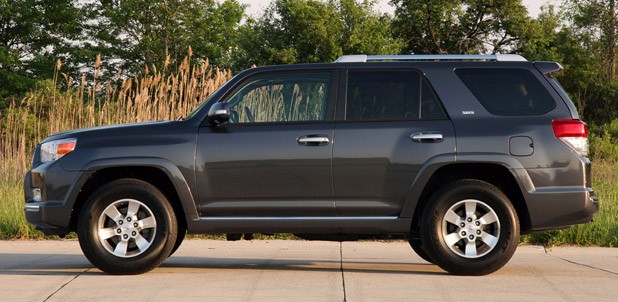
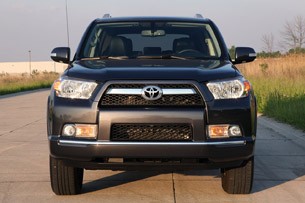
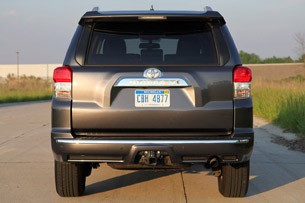
We liked the 4Runner's comfortable leather seats, commanding view of the road and roomy dimensions, but there were a few notable problems within this Toyota's cabin. First, one of the most amusing buttons we've ever seen in any vehicle appeared in our tester: the "Party Mode" button. Sadly, Ryan Seacrest's short and suited self doesn't pop out whenever we pressed it. Instead, the sound system's music goes from clean to heavy on the bass and over-modulated. The stereo doesn't actually sound that bad in "Party Mode," but we're not sure why Toyota has elected to place the button a foot away from the headunit and behind that massive steering wheel we told you about. We didn't see the button for the first four days behind the wheel and may never have stumbled across it if one of our other editors didn't alert us to its existence.
Interior quality is also a bit uneven, as the 4Runner's dash plastic is unyielding, and touchpoints at the door and center armrest are surprisingly harsh and rubbery. We understand (but don't like) the use of hard plastics on a meat-and-potatoes SUV dashboard, but touchpoints deserve a bit more love. An even bigger problem presented itself in the form of our tester's third row seat, which is a $3,570 option that included leather seating surfaces and third row curtain airbags.
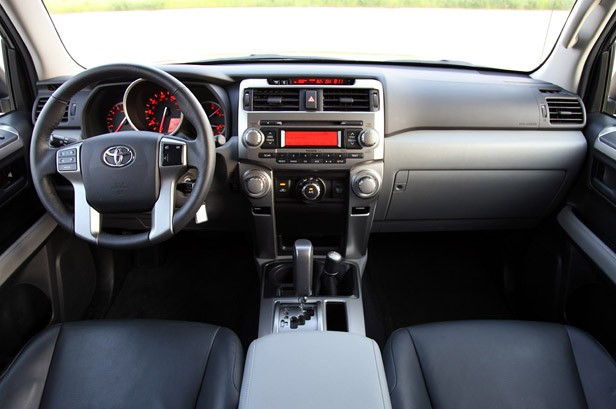
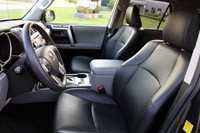
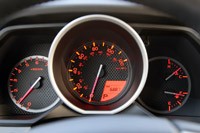
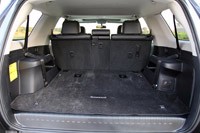
Since the 4Runner has a body-on-frame architecture, when the third row seat is folded, the load floor actually sits a few inches higher than in the standard five-seat model. The fully collapsed seats don't exactly stow completely flat, either, and the slight downward pitch of the floor makes it next to impossible to throw groceries in the boot without something flying out when the tailgate is opened. There is no convenient way to access that third row when it's needed, either. We found that we had to unfold the third row split-bench from the second row, which certainly isn't the most user-friendly way to access additional seating.
But while the interior wasn't exactly up to snuff, there were some considerable surprises once we got behind the wheel. The first area of delight came courtesy of Toyota's 4.0-liter V6 engine. This writer just finished a week in a Tacoma with the same displacement V6, and we came away from that tester wanting far more power. The six-pot beneath the hood of the 4Runner is a different beast altogether, with dual independent variable valve timing helping to achieve 270 horsepower at 5600 rpm and 278 pound-feet of torque at 4400 rpm. The extra horsepower (up from 236 ponies in the Tacoma) makes the 4,700 pound 4Runner feel surprisingly fleet-footed, and Toyota claims an impressive 0-60 mph time of 7.1 seconds. Perhaps more surprising than the 4Runner's perkiness is the impressive 19.5 miles per gallon we managed during a week of mixed driving (EPA figures: 18 mpg city/23 mpg highway). Not bad for a two-ton SUV with a five-speed transmission and large-displacement V6.
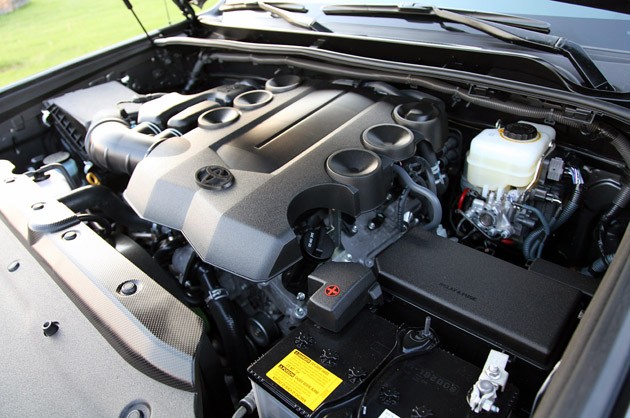
Our tester also proved to be very comfortable on the highway and around town, with the V6 providing reliable power and the chassis remaining well-controlled. Steering is a bit numb and could use a bit more heft when tooling around town, but it's about what you'd expect in an off-road capable SUV. It's true that the 4Runner's ride quality tends to get a bit bouncy when encountering less-than-ideal roads, but that's largely to be expected in a steel-spring off-roader like this.
The SR5 also has a not-so secret weapon in its very capable part-time four-wheel-drive system. On the highway, it can cruise comfortably using only the rear wheels for propulsion, but when the traction conditions turn foreboding, the driver can simply shift into Four High to keep momentum strong. When dirt turns to rock, the 4Runner can articulate over some pretty formidable terrain. Simply work your way into Four Low and let the 9.6-inch ground clearance, 25-degree approach angle and 24-degree departure angle work to your advantage. Toyota also has an even more rugged option in the form of a Trail package that includes a terrain response system, a locking rear differential, and skid plates for still more off-roading ability.
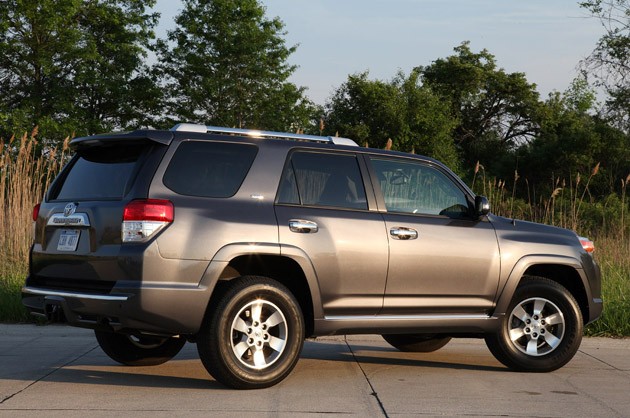
We rarely find ourselves short on fun when we're off the beaten path, and here the 4Runner revealed itself to be a very capable partner. Substantial P265/70SR17 tires and above average wheel travel made most pits feel like small potholes, and the 4WD system proved to be very difficult to overwhelm. One problem we encountered was that it was fairly difficult to switch the 4Runner's floor-mounted 4WD system shifter into 4WD High and Low. We got better with a bit of practice, though we'd much prefer a simple button or switch that interfaces with the 4WD system.
The Toyota 4Runner may be every bit as safe and reliable as Toyota models of the past, but it also has a bit of attitude in its design and capability, and that's a good thing. And with the Chevrolet Trailblazer gone and the Ford Explorer and Dodge Durango about to reinvent themselves as crossovers, the 4Runner has very little competition in a segment that just a decade ago surpassed well over one million units per year. In the end, customers will have to decide if they really do want to go off-road every now and again. The genre's sales may be dwindling, but with the 4Runner's history spanning a quarter of a century and 1.5 million units sold over four generations, we're guessing that Toyota will find enough loyalists who still think a bit of grit under their fingernails – and tires – is an attractive thing.
Photos by Chris Shunk / Copyright ©2010 Weblogs, Inc.
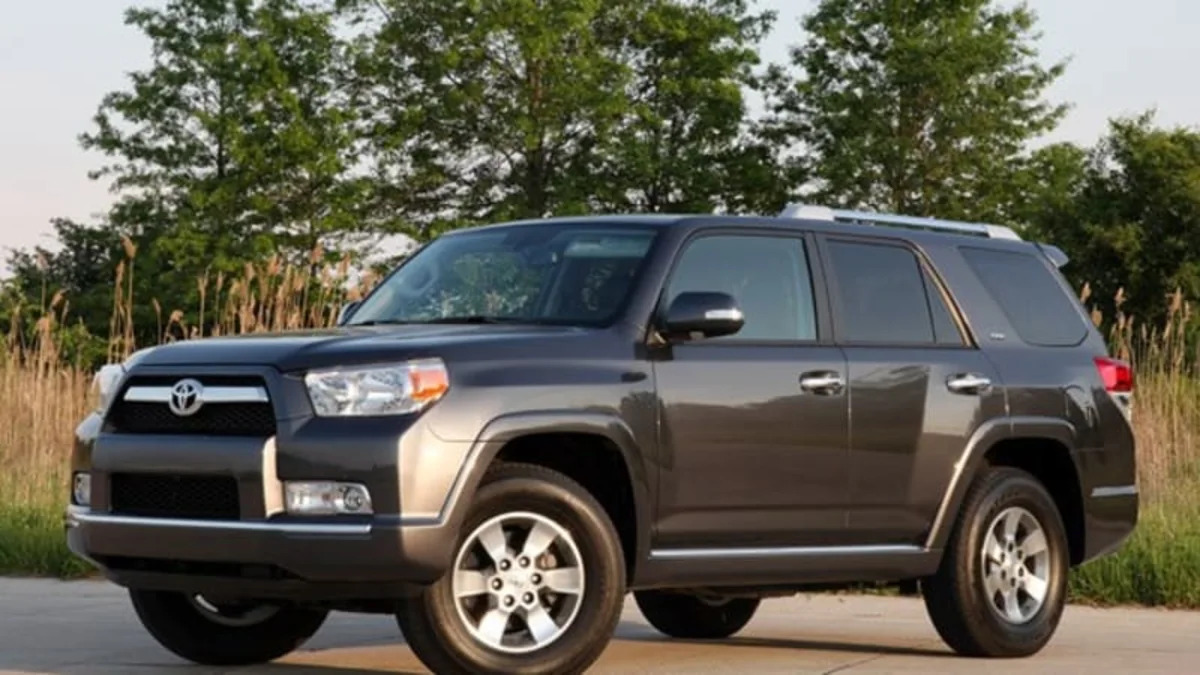


Sign in to post
Please sign in to leave a comment.
Continue